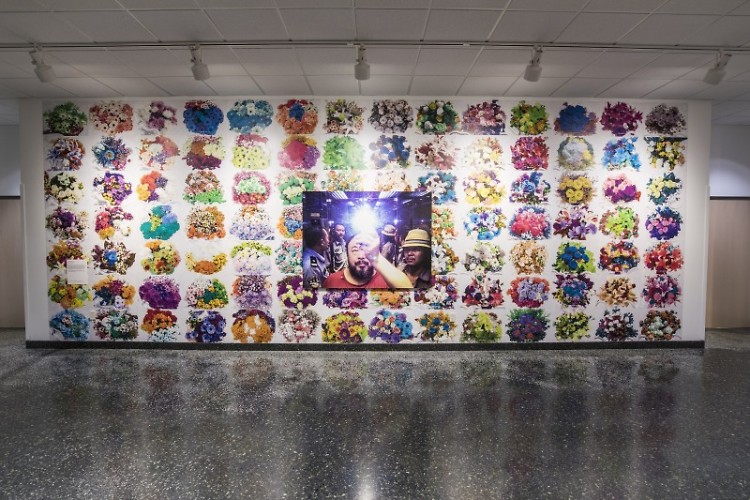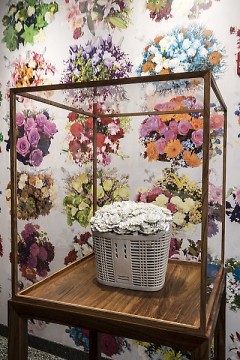Seemingly contrasting themes of tradition and modernity are critical to the work of Ai Weiwei. The Chinese-born artist and activist is internationally heralded as one of the most important cultural figures of our time. He champions free speech and global human rights through his sculpture, installations, film, photography—and his widely followed social media presence. In the last year alone, he has mounted critically acclaimed exhibitions in London, Helsinki, Paris, Melbourne, Florence and New York. His work, through a never-ending variety of materials and forms, communicates important concepts about his life, his homeland and the world.
Ai Weiwei at Meijer Gardens: Natural State marks the artist’s first exhibition at a botanical garden and sculpture park anywhere in the world, and his premier solo presentation in the upper Midwest. Working with both the sculpture and horticulture departments at Meijer Gardens over the last two years, Ai Weiwei has carefully developed a large-scale exhibition intended to share profound ideas through innovative artwork. In addition to four sculpture galleries, the artist will use four conservatories and numerous public areas of the building. Combined, it’s an exhibition of unprecedented scope, presenting both iconic and recently created work.
The title of the exhibition, Ai Weiwei at Meijer Gardens: Natural State, underscores the relationship between artist and institution. It began in 2014 with the acquisition of the colossal sculpture Iron Tree, a gift of Fred and Lena Meijer. Further, it calls attention to the unique circumstances in the artist’s generous decision to exhibit at an organization whose mission is dually focused on horticulture and sculpture. Ai Weiwei and his studio teams in Beijing and Berlin have worked diligently and sensitively to engage with the whole of Meijer Gardens.
The word “natural” sheds light on numerous instances in which the artist will use imagery from the natural world to introduce persuasive ideas and concerns. From meticulously rendered flowers to legions of painstakingly crafted river crabs, references to nature are employed to engage the viewer, leading them to consider important concepts. Although well known for his use of found objects, the word “natural” also calls attention to Ai Weiwei’s thoughtful use of natural materials, from ceramics and silk to bamboo and wood. Often these natural materials are transformed, following time-honored Chinese craft traditions.
Likewise, the word “state” suggests multiple, often interrelated levels of meaning. On the one hand, it may convey a state of being for both a found object or material that the artist uses in a new and innovative way. For example, an ancient urn or a LEGO brick exists in a specific state when the artist encountered them, but he often re-employs them in a new manner to guide and communicate with his audience. A state of being has a human side as well, thematically exploring aspects of humanity across the globe as they are frequently marked by inequality and injustice. These are states of being that the artist feels compelled to call out in order to better the lives of women, men and children everywhere.
Certainly the notion of state refers to political systems that Ai Weiwei has bravely challenged for the betterment of humanity in his native China, but also in the Middle East, Europe and Africa, where he has travelled extensively in recent years. “Today the whole world is still struggling for freedom,” says the artist. “In such a situation, only art can reveal the deep inner voice of every individual with no concern for political borders, nationality, race or religion.”
Ai Weiwei at Meijer Gardens: Natural State explores several important themes across the artist’s repertoire. Among the most widespread and engaging are those that involve his own biography. Born in Beijing in 1957, he is the son of the renowned poet Ai Qing (1910–1996). In the following year, his father was labeled an “enemy of the people” and the entire family was exiled to a re-education camp in remote northwestern China. The young Ai Weiwei spent his entire youth until the age of 19 living in the very conditions symbolic of the alienation of free speech in Maoist China. With the death of Mao Zedong in 1976, the family was able to return to Beijing.
Ai Weiwei enrolled in the Beijing Film Academy in 1978 and was among the original members of the avant-garde collective known as the “Stars.” Following a brief period of political openness in China, there was a repression of expression and cultural crackdown, and the young artist left for America in 1981. After a brief period in Philadelphia, the artist lived in New York until 1993. Here, his interest in photography brought him close to the most compelling social and political issues of the day. Additionally, he was exposed to the work of three of the most important artists of the 20th century: Marcel Duchamp, Jasper Johns and Andy Warhol. Each a conceptual master, they are celebrated for the use of found objects or popular culture, greatly influencing Ai Weiwei through to the present day.
When his father fell seriously ill in 1993, Ai Weiwei returned to China. But after 12 years in the United States, he confronted a Chinese society that lacked freedom of speech and constrained fundamental human rights. He embarked on an intense period of writing and publishing, as well as organizing and presenting performances and exhibitions that examined the duality of belonging and rebellion. In 1995, the artist created Dropping a Han Dynasty Urn. This triptych of large-scale photographs symbolically challenges the repressive cultural history of China in 20th cum 21st centuries through the destruction of a 2,000-year-old vase. The Meijer Gardens’ 2016 version has been recreated with innocent and globally ever-present LEGO bricks, which the artist has utilized in recent years. The use of found objects recalls the impact of Duchamp and Johns, while the use of popular culture items are a hallmark to the work of Warhol.
By the late 1990s, Ai Weiwei developed skills as an architect, eventually collaborating with the firm Herzog and DeMeuron on the “Bird’s Nest” stadium for the 2008 Beijing Olympics. This was an extremely important period for the artist. In 2008, he was a signatory of the 60th anniversary of the Declaration of Human Rights and used his acclaim and social media savvy as an activist. This period was also marked by the devastating Sichuan Province earthquake. The disaster led the artist to organize volunteers to investigate the deaths of thousands of schoolchildren in collapsed buildings that were marked by substandard government construction. His involvement led to his censorship by the Chinese government, his arrest and his subsequent beating.
Illumination is perhaps among the most poignant images in the exhibition. With extraordinary presence of mind, Ai Weiwei captured a “selfie” at the time of his arrest and later tweeted it to the world. The title suggests a moment of light, enlightenment and clarity that was critical to share. In the years following, he was closely monitored by Chinese officials, climaxing in his secret arrest on April 3, 2011 and his imprisonment for 81 days. Although released, his passport was confiscated and he was unable to travel until July 2015.
Several of the works on display in the Meijer Gardens exhibition symbolically narrate personal events that have a broader, even universal importance. The extraordinarily crafted porcelain sculpture Bicycle Basket with Flowers in Porcelain is among them. Beginning in November 2013, Ai Weiwei placed a bouquet of fresh flowers in the basket of his bicycle outside his Beijing studio and continued this action every day until his passport was returned. A personally poetic act of symbolic beauty was a show of defiance against state repression at large. This sculpture and related photography are among those that commemorate a daily activity in more permanent terms.
However, the sculpture is equally a visual tour de force for the traditional Chinese craftsmanship of porcelain, which dates back centuries in Jingdezhen, the ancient capital of fine porcelain ware. Similarly, the breathtaking sculptural field Blossom never fails to astonish the eye, but ultimately its connection to the “Hundred Flowers Movement,” when Chinese officials briefly relaxed their stance on freedom of expression in 1956, cannot be denied. The work, like the movement itself, is beautiful but fragile.
The balance between visual delight or intrigue and multiple layers of meaning is what sets Ai Weiwei apart from many of his contemporaries and continually captures the attention of the international cultural community. He Xie, another major work in porcelain, astounds even the most casual viewer with hundreds of life-like river crabs. At one level, the installation refers to a critical moment when the artist was placed under house arrest while his new studio was demolished by authorities. But in an act of defiance, the artist treated 800 guests to a feast of river crabs. At a broader, cultural level, he xie means “river crab” and is a homonym for “harmony” in Chinese, a government slogan which has come to mean “censorship,” especially with regard to the internet.
The artist’s regard for traditional Chinese culture can be lyrical as well, as featured in five colossal creatures made from bamboo and silk. Each fantastical form was inspired by the artist’s adult reading of the 2000-year-old Chinese mythology, Classic of Mountains and Seas—which he was unable to read as a youth. Masterpieces like Taifeng, the god of luck, mesmerize in innovative form and scale, but also captivate through the adaptation of traditional Chinese kite making techniques from Weifang, Shandong Province.
Ai Weiwei at Meijer Gardens: Natural State is an unprecedented exhibition in scale and meaning, with more than 30 works by one of the most distinguished artists of our time. From galleries to conservatories, from public spaces to our auditorium, the transformation of Meijer Gardens will be unlike any other project for the organization. In sharing his biography, ideas and concerns for freedom of speech and human rights, Ai Weiwei is truly a global leader. His sculptures, installations, photography and film engage, challenge, and astonish—and remind us that “Art is not an end, but a beginning.”
The Rapidian, a program of the 501(c)3 nonprofit Community Media Center, relies on the community’s support to help cover the cost of training reporters and publishing content.
We need your help.
If each of our readers and content creators who values this community platform help support its creation and maintenance, The Rapidian can continue to educate and facilitate a conversation around issues for years to come.
Please support The Rapidian and make a contribution today.


